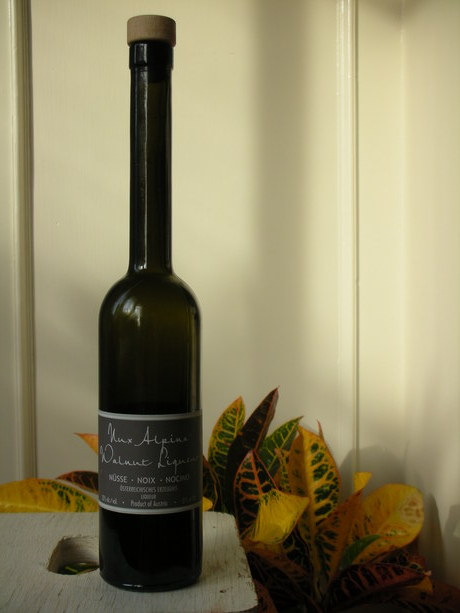|
Nespolino
Nespolino is an Italian liqueur made from the seeds of the loquat fruit. It has bitter taste reminiscent of other Italian seed-based bitter liqueurs such as amaretto and nocino Nocino is a dark brown liqueur from the Emilia-Romagna region in northern Italy. It is made from unripe green walnuts. The walnuts and the liquor are handled using ceramic or wooden tools (to avoid oxidation) and placed in an alcoholic base. Aft ..., both prepared from nuts and apricot kernels. Both the loquat seeds and the apricot kernels contain cyanogenic glycosides, but the drinks are prepared from varieties that contain only small quantities (such as Mogi and TanakaTropical and Subtropical Fruits: Postharvest Physiology, Processing and Packaging. Editor(s): Muhammad Siddiq, https://books.google.com/books?id=5_xMc9xr1ZwC&pg=PT1140&lpg=PT1140&dq=loquat+cyanide+tanaka&source=bl&ots=ugCZAUQOCd&sig=VON6KW1xFJ1KFzJKlWEsEznyqRI&hl=en&sa=X&ei=xw98UYXvDMW2hAeaoYCoCQ&redir_esc=y), so there is no risk of cyani ... [...More Info...] [...Related Items...] OR: [Wikipedia] [Google] [Baidu] |
Loquat
The loquat (''Eriobotrya japonica'') is a large evergreen shrub or tree, grown commercially for its orange fruit and for its leaves, which are used to make herbal tea. It is also cultivated as an ornamental plant. The loquat is in the family Rosaceae, and is native to the cooler hill regions of south-central China. In Japan the loquat is known as biwa (枇杷, びわ) and has been grown for over 1,000 years. The loquat has been introduced to regions with subtropical to mild temperate climates throughout the world. ''Eriobotrya japonica'' was formerly thought to be closely related to the genus ''Mespilus'', and is still sometimes mistakenly known as the Japanese medlar. It is also known as Japanese plum and Chinese plum, as well as pipa in China, naspli in Malta, Lukaat in India, Lucat in Sri Lanka, níspero in Spain, nêspera in Portugal, shések in Israel, akidéné in Lebanon, Ebirangweti in Kisii and nespolo in Italy (where the name is shared with ''Mespilus germanica''). ... [...More Info...] [...Related Items...] OR: [Wikipedia] [Google] [Baidu] |
Amaretto
Amaretto (Italian for "a little bitter") is a sweet Italian liqueur that originated in Saronno. Depending on the brand, it may be made from apricot kernels, bitter almonds, peach stones, or almonds, all of which are natural sources of the benzaldehyde that provides the almond-like flavour of the liqueur. It generally contains 21 to 28 percent alcohol by volume. When served as a beverage, amaretto can be drunk by itself, used as an ingredient to create several popular mixed drinks, or added to coffee. Amaretto is also commonly used in culinary applications. Origin Etymology The name ''amaretto'' originated as a diminutive of the Italian word ''amaro'', meaning "bitter", which references the distinctive flavour lent by the ''mandorla amara'' or by the drupe kernel. However, the bitterness of amaretto tends to be mild, and sweeteners (and sometimes sweet almonds) enhance the flavour in the final products.Hopkins, Kate"Almonds: Who Really Cares?" (August 28, 2004). Accidental Hed ... [...More Info...] [...Related Items...] OR: [Wikipedia] [Google] [Baidu] |
Nocino
Nocino is a dark brown liqueur from the Emilia-Romagna region in northern Italy. It is made from unripe green walnuts. The walnuts and the liquor are handled using ceramic or wooden tools (to avoid oxidation) and placed in an alcoholic base. After steeping in Liquor, spirit, the walnuts are removed and the alcohol is mixed with simple syrup. Nocino has an aromatic but bittersweet flavor. It may be homemade; villages and even individual families often have their own (oftentimes secret) recipes, including different additions like cinnamon, juniper berries, lemon or Orange (fruit), orange zest, vanilla pods, coffee beans, or clove. The spices are added lightly, to avoid overpowering the flavour of the walnuts. The classic base consists of pure alcohol but vodka can also be used. Nocino is also available commercially in bottled form. Commercially available nocino is typically 40 percent alcohol by volume, or 80 proof. History According to Ancient Rome, Roman historians, the nocino ac ... [...More Info...] [...Related Items...] OR: [Wikipedia] [Google] [Baidu] |
Italian Cuisine
Italian cuisine (, ) is a Mediterranean cuisine#CITEREFDavid1988, David 1988, Introduction, pp.101–103 consisting of the ingredients, recipes and List of cooking techniques, cooking techniques developed across the Italian Peninsula and later spread around the world together with waves of Italian diaspora. Some of these foods were imported from other cultures. Significant changes Columbian Exchange, occurred with the colonization of the Americas and the introduction of potatoes, tomatoes, capsicums, maize and sugar beet — the latter introduced in quantity in the 18th century. It is one of the best-known and most appreciated Gastronomy, gastronomies worldwide. Italian cuisine includes deeply rooted traditions common to the whole country, as well as all the Regional cuisine, regional gastronomies, different from each other, especially between Northern Italy, the north, Central Italy, the centre and Southern Italy, the south of Italy, which are in continuous exchange. Many di ... [...More Info...] [...Related Items...] OR: [Wikipedia] [Google] [Baidu] |


